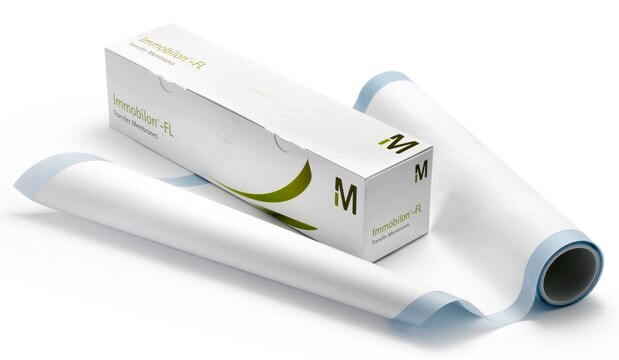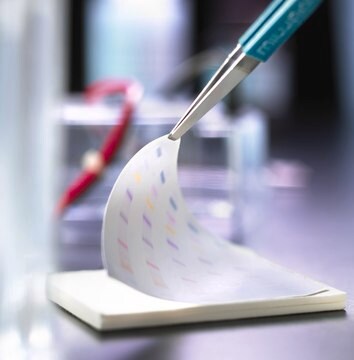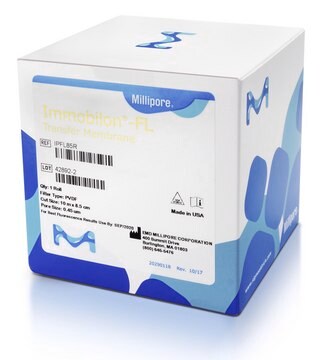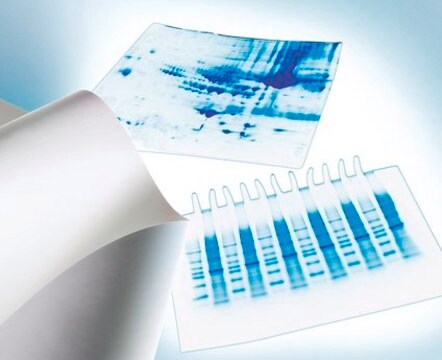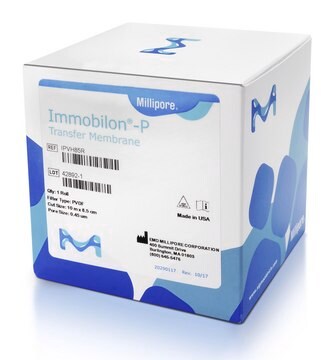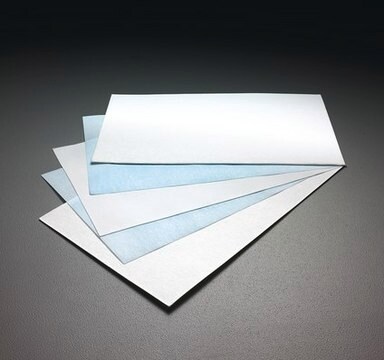IPFL10100
Immobilon® -FL PVDF Membrane
10 sheets, 10 cm x 10 cm, 0.45 µm pore size, transfer membrane with low background fluorescence
Sinonimo/i:
Western blotting membrane, blotting membrane, transfer membrane
About This Item
Prodotti consigliati
product name
Immobilon®-FL PVDF Membrane, 10 sheets, 10 cm x 10 cm, 0.45 µm pore size, Hydrophobic PVDF Transfer Membrane with low background fluorescence for Western blotting. Compatible with visible and infrared fluorescent probes.
Materiali
PVDF membrane
plain filter
white filter
Livello qualitativo
Caratteristiche
hydrophobic
Produttore/marchio commerciale
Immobilon®
tecniche
dot blot: suitable
western blot: suitable
Lungh. × largh. filtro
10 cm × 10 cm
Dimensione pori
0.45 μm pore size
Capacità
155 μg/cm2 adsorption capacity (insulin)
205 μg/cm2 adsorption capacity (BSA)
300 μg/cm2 adsorption capacity (goat IgG)
Compatibilità
for use with Amido black
for use with CPTS
for use with Coomassie brilliant blue
for use with Ponceau-S red
Metodo di rivelazione
chemiluminescent
colorimetric
fluorometric
Condizioni di spedizione
ambient
Descrizione generale
Applicazioni
Caratteristiche e vantaggi
- The first transfer membrane designed for fluorescence applications Extremely low background improves the sensitivity of all fluorescence detection protocols
- Compatible with all commonly used fluorescent probes at all excitation and emission wavelengths
- compatible with standard blocking agents and buffers
- Ideal for multiplexing and chemifluorescence detections
Note legali
Codice della classe di stoccaggio
11 - Combustible Solids
Classe di pericolosità dell'acqua (WGK)
WGK 3
Punto d’infiammabilità (°F)
Not applicable
Punto d’infiammabilità (°C)
Not applicable
Certificati d'analisi (COA)
Cerca il Certificati d'analisi (COA) digitando il numero di lotto/batch corrispondente. I numeri di lotto o di batch sono stampati sull'etichetta dei prodotti dopo la parola ‘Lotto’ o ‘Batch’.
Possiedi già questo prodotto?
I documenti relativi ai prodotti acquistati recentemente sono disponibili nell’Archivio dei documenti.
I clienti hanno visto anche
Il team dei nostri ricercatori vanta grande esperienza in tutte le aree della ricerca quali Life Science, scienza dei materiali, sintesi chimica, cromatografia, discipline analitiche, ecc..
Contatta l'Assistenza Tecnica.